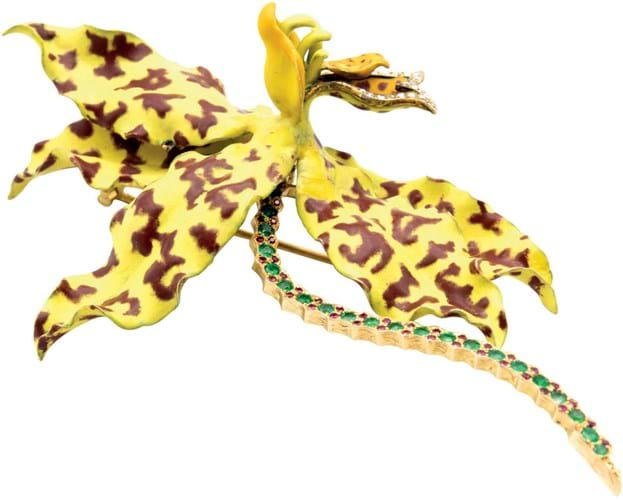
The exhibit, artfully suspended from fine wires above the main showcase, was singled out for its ‘fertility of imagination and power of invention’ and won a gold medal – the first ever awarded to an American firm.
Much of the credit went to the project’s artistic director George Paulding Farnham (1859-1927). He worked at Tiffany from 1879 but the orchid brooches are among the first pieces that can be firmly attributed to him. Some of the original watercolour sketches are pictured in John Loring’s Paulding Farnham: Tiffany’s Lost Genius (2000).
Paulding Farnham had chosen a topical subject matter. His brooches paralleled a contemporary fashion for orchid cultivation that had begun in the UK and spread to the US by the end of the 19th century. They called it orchidomania.
For his designs he enjoyed access to the Tiffany library, which contained many natural history journals, and to both live and preserved botanical specimens purchased for the design studio.

Tiffany enamel and gemset orchid brooch, c.1890, designed by Paulding Farnham – £50,000 at Elstob & Elstob.
The hyper-realistic brooches and hair pieces were often created by electroforming the flower from life before the application of enamel and precious stones.
Gustav Stickley, leader of the American Arts & Crafts movement, said at the time: “The copying of flowers in jewellery is, of course, no new thing… but the orchids of Messrs Tiffany are the first that we have seen, and it would be impossible to surpass them, whether for cleverness of imitation or for perfection of workmanship.”
They proved hugely popular. All brooches offered at the 1889 expo had sold by the second day and by April 1890 the number of varieties offered at Tiffany stores in Paris and New York had increased from 24 to 41. However, as they enjoyed a relatively short production run until around 1896, each survivor is a rarity.
The example offered in a ‘live online’ auction held by Elstob & Estob in Ripon on April 18 was modelled as a tiger orchid (grammatophyllum speciosum), a species native to Indonesia.
The flowerhead is applied with yellow, brown and orange enamels with rose-cut diamond highlights to the stamen and a sinuous stem set with circular-cut emeralds and rubies. Signed Tiffany & Co to the reverse on the pin fitting and stamped with a French import mark, the brooch was in good condition save an area of possible retouching.
Pitched at a punchy £40,000-60,000, it sold to a buyer in France underbid by a US client for £50,000 (plus 22% buyer’s premium).
“It was really a case of a buyer sat at home surfing his computer during lockdown and finding something he had always wanted,” said auctioneer David Elstob.
“He spotted it the day before the sale and rang us in a panic. I was able to put him in touch with our jewellery specialist [Inez Tobin who joined as a consultant earlier this year] who talked him through it.”
A near-identical tiger-orchid brooch was sold by the Belgian auction house Haynault of Woluwe-Saint- Pierre in June last year for €41,000 (£36,000), close to four times the estimate.














